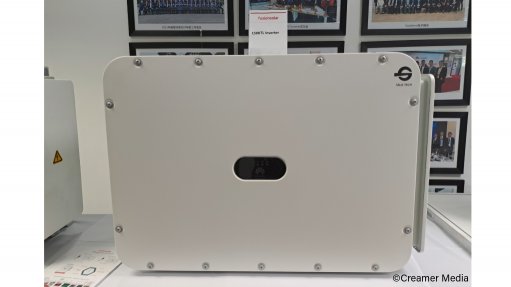
150KTL inverter demo
Photo by: Creamer Media's Tasneem Bulbulia
Global provider of solar solutions Huawei FusionSolar has launched its largest commercial and industrial (C&I) inverter available to the market to date, the 150K high-power C&I inverter series.
The series comprises the SUN2000-150K-MGO and the SUN5000-150K-MGO.
The former is powered by solar PV only, while the latter requires an optimiser.
Speaking at the launch on July 19, Huawei Digital Power sub-Saharan Africa president Xia Hesheng said this launch was part of the company’s efforts to help build a high-quality solar industry in the country.
He pointed out that this goal was supported by the necessary fundamentals, with demand for PV and energy storage systems (ESS) thriving in Africa and South Africa.
Hesheng pointed out that, over the past two years, commodity prices for two key components of solar PV and ESS – PV modules and lithium carbonate – had decreased considerably, driving growth of their uptake by industry, globally and regionally.
He said this was evidenced by projections from now to 2030 indicating a yearly installed PV capacity in Africa of 6 GW to 7 GW, and yearly installed ESS of 3 GWh.
Meanwhile, in South Africa, where loadshedding has remained suspended for nearly four months by July, new PV and inverter installations have slowed down drastically, compared with the significant activity experienced over the preceding three years, when loadshedding had peaked.
Hesheng explained that when there was no prolonged period of power outages, residential energy users were less likely to install solar power, given that electricity does not constitute a large percentage of their monthly expenses. In contrast, installing a residential PV or ESS system is a hefty expense.
However, he said the C&I market, which also experienced a similarly “crazy” period in response to loadshedding in recent years, has now, in comparison, eased into a “rational” state.
Here, company money is spent, rather than individual, and it is a long-term investment.
Therefore, Hesheng said that while there was still demand from the C&I market, the drivers behind this have changed. Currently, and in the future, this was expected to be driven by businesses seeking cost-effective, green power, rather than merely solutions to prevent outages.
He added that interactions with stakeholders had shown that the return on investment on PV and ESS systems had shortened from about eight to ten years, to four to five years. With the systems running for about 30 years, it was a sound investment, he averred.
Therefore, with demand persisting, the company has launched this new inverter as part of its drive for continuous innovation and investment in research and development.
Hesheng emphasised that Huawei considered the inverter as core to a C&I power plant.
He explained that while an inverter only constituted between 10% and 15% of the total investment of a C&I power plant, it considerably impacted on the power generation, electricity conversion and electricity optimisation, as well as the safety and reliability of the overall plant.
Therefore, Hesheng emphasised that this about 15% total investment was actually responsible for about 95% of the power plant’s value return.
Hesheng also mentioned that Huawei boasted a highly credible quality record, with this built into the development process.
150K SERIES
This series boasts six key features, namely active safety, more energy, long-term reliability, simplified operations and maintenance, optimal balance of system, and being grid-friendly.
In terms of active safety, it offers seven protections for eight types of direct current faults.
Further, it boasts a 98.8% maximum efficiency and a 99.8% dynamic maximum power point tracking efficiency.
In terms of long-term reliability, product availability is 99.999%, engendered through reliable design, high-standard components, meticulous inspection and 1 400 rigorous tests.
The grid-friendly facet is enabled through intelligent reactive power compensation and intelligent harmonic algorithm. A built-in potential-induced degradation repair improves yields by 3%.
New features that the series boasts, compared with previous models, include higher power, PV ground-fault protection, smart connector temperature detection and module-level isolation fault detection.
The series has yet to be installed in South Africa, but there are successful case studies in other countries that can be used as a point of reference.
Moreover, Huawei indicated at the launch event that orders for the 150k series had already been placed by local buyers.